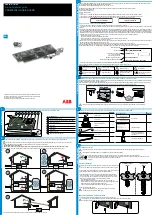
HOBO
MX
Soil
Moisture
(MX2306)
and
MX
Soil
Moisture
and
Temperature
(MX2307)
Data
Logger
Manual
1
‐
508
‐
759
‐
9500
(U.S.
and
International)
8
www.onsetcomp.com
1
‐
800
‐
LOGGERS
(U.S.
only)
Trench
Installation
Method
This
method
is
best
for
shallow
installations
at
less
than
40
cm
(15.7
inches).
This
requires
digging
a
trench
with
a
shovel,
excavator,
or
other
tool
to
the
depth
of
the
deepest
installed
sensor
(if
installing
more
than
one
in
the
measurement
location).
For
deep
installations,
this
may
require
a
large
trench.
The
sensor
is
then
installed
carefully
by
hand
into
the
undisturbed
soil
of
the
trench
sidewall.
The
trench
is
carefully
backfilled
to
preserve
the
bulk
density
of
the
soil
and
avoid
dislodging
the
installed
sensor
by
accidentally
snagging
the
ferrite
core.
Sensor
Installation
Guidelines
Before
installing
the
sensor,
follow
these
guidelines:
Test
the
sensor
functionality
and
accuracy
using
the
TEROS
verification
clip.
With
the
verification
clip
attached,
the
readings
should
be
in
the
range
of
0.35
to
0.42
m
3
/m
3
.
Refer
to
the
TEROS
verification
clip
documentation
for
more
information.
If
you
do
not
have
a
verification
clip,
you
can
perform
a
rough
check
of
sensor
functionality
in
air
and
water.
The
sensor
will
produce
readings
of
~0.64
m
3
/m
3
in
water
(sensor
fully
submerged
in
water
to
1
cm
up
cable)
and
slightly
negative
in
air.
Use
HOBOconnect
to
export
or
view
the
data
for
your
test.
When
creating
the
hole
to
install
the
sensor,
avoid
interfering
objects.
Installation
near
large
metal
objects
can
affect
the
sensor
function
and
distort
readings.
Large
objects
like
roots
or
rocks
could
potentially
bend
the
needles.
The
sensor
may
be
positioned
in
any
direction.
However,
there
is
less
restriction
to
water
flow
when
the
sensor
body
is
placed
in
a
vertical
position
as
shown
below.
A
vertical
position
will
also
integrate
more
soil
depth
into
the
soil
moisture
measurement.
Installing
the
sensor
with
the
sensor
body
in
a
horizontal
position
will
provide
measurements
at
a
more
discreet
depth.
Avoid
any
metal
located
between
the
sensor
and
the
ferrite
core
because
it
can
interfere
with
VWC
measurements.
When
installing
sensors
in
rocky
soils,
use
care
to
avoid
bending
sensor
needles.
Minimize
air
gaps
around
the
sensor.
Air
gaps
around
the
sensor
needles
will
result
in
low
readings
of
soil
moisture.
Use
conduit
to
protect
the
cable
against
damage
from
animals,
lawn
mowers,
exposure
to
chemicals,
etc.
Secure
any
loose
cables
with
cable
ties.
Sensor
Installation
Instructions
1.
Auger
or
dig
a
hole
to
the
desired
sensor
depth.
2.
Carefully
insert
the
sensor
in
the
hole
and
push
the
sensor
so
that
the
needles
are
inserted
into
the
undisturbed
side
of
the
soil.
Check
that
the
sensor
is
firmly
seated.
3.
If
using
the
temperature
sensor
for
soil
temperature,
insert
that
into
the
side
of
the
hole,
at
least
2
cm
(1
inch)
from
the
soil
moisture
sensor
and
ferrite
core.
4.
Secure
the
cable(s)
and
install
conduit
before
backfilling
the
hole.
5.
Carefully
return
the
soil
to
the
hole,
packing
it
back
to
its
native
bulk
density.
Do
not
hit
the
ferrite
core
as
this
could
pull
the
sensor
from
the
soil.
6.
If
using
the
MX2307
logger
for
air
temperature,
a
solar
radiation
shield
is
required
if
the
temperature
sensor
will
be
in
sunlight
at
any
time.
(See
Accessories)
Deploying
and
Mounting
the
Logger
Follow
these
guidelines
when
deploying
the
logger:
Mount
the
logger
so
the
sensor
cable
is
not
being
pulled.
Leave
about
5
cm
(2
inches)
of
drip
loop
in
the
cable
where
it
comes
out
of
the
logger
to
prevent
water
from
entering
the
logger
housing.
Use
the
included
large
screws
or
cable
ties
to
mount
the
logger
via
the
mounting
holes.
Use
the
screws
to
attach
the
logger
to
a
wall
or
flat
surface.
Use
the
cable
ties
to
affix
the
logger
to
a
PVC
pipe
or
mast.
Protecting
the
Logger
Note:
Static
electricity
may
cause
the
logger
to
stop
logging.
The
logger
has
been
tested
to
8
KV,
but
avoid
electrostatic
discharge
by
grounding
yourself
to
protect
the
logger.
For
more
information,
search
for
“static
discharge”
on
onsetcomp.com.
Drip
Loop



























